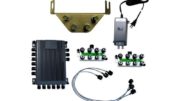When you’re looking to upgrade your RV, you will get a lot of opinions. You can do internet searches and get a lot of information, but a lot of it won’t be true. In fact, a lot of what you read will go against a lot of the other stuff you read. Who can you trust? The Solid Signal Blog is part of Signal Group, and Signal Group does more communications tech upgrades for RVers than anyone else on the planet.
We’re just as frustrated as you about all that misinformation, and here are the five most common myths that just aren’t true.
Myth 1: You’ll get great cell service while you’re on the road so you don’t need a cell phone signal booster.
The Truth: Like all myths, there is a grain of truth in there. Cell carriers have spent literally billions of dollars blanketing our highways with cell towers. That should mean everyone gets great service, at least while they’re on the interstate. The truth is a little different.
RVs themselves do a great job of blocking cell signals. From the fiberglass body to the metal frame, wiring, and even the hardwood cabinets, everything in an RV is practically designed to keep you from getting good reception. That’s why you’ve probably noticed that service is a lot worse in the back of the RV than in the cab.
Cell phone signal boosters level the playing field by bringing that strong signal from outside into the RV through a wire. Then the signal is amplified even more and pumped out to your devices.
Myth 2: Satellite TV is an expensive waste of money since you can stream stuff anyway.
The Truth: A lot of folks put satellite TV systems into their RVs in the 2000s and 2010s when streaming wasn’t as advanced as it is today. But does that mean satellite TV is a waste of money? It doesn’t. Satellite TV is available anywhere that you have a good view of the southern sky. That means those out-of-the-way RV parks, national parks, pretty much everywhere. Not only that, but satellite TV will deliver consistently better quality even if you are only able to get standard definition service.
Satellite TV is a must-have for tailgaters, since tailgaters love to run multiple televisions. This isn’t really possible with streaming, unless you have multiple devices that can provide all that bandwidth.
If you have satellite TV at home, you can often just add the RV as an auxiliary receiver and the cost is really very low. But, you have to know how to do it and you’ll need an expert on your side.
Myth 3: You don’t need a hotspot because you can tether with your phone.
The Truth: Have you checked the fine print of your cell phone plan? Most allow some amount of tethering, but you’ll run out of data quickly if you stream video. Plus, the video streams through your cell phone may be intentionally low quality.
Cell phone tethering is great. It’s there when you need it. But your phone isn’t really designed to be a hotspot and its Wi-Fi signal might not reach the entire RV. Using a hotspot generally gives you a lot better range plus a larger pool of data to use.
Not all hotspots are created equal, though. Some are hard to set up and some aren’t even reliable. You need to know you can trust a hotspot if you’re going to work from the RV.
Myth 4: You can’t get HD video or 4K from RV satellite systems.
The Truth: There’s a lot of confusion about the kind of satellite TV service you can get with your RV. It’s true that there are limitations, and it’s worth talking about what they are.
DISH satellite TV
With DISH, you can absolutely get HD and even 4K while you’re in your RV. In-motion systems can pick up one satellite at a time so channel changes may be very slow. There’s another type of dish which only works while you’re parked. It’s essentially the same dish you have at home. However, if you travel too far from home you might have trouble because DISH has two fleets of satellites, one for each side of the country. Each fleet needs its own dish.
DIRECTV satellite TV
With DIRECTV, there are very few channels available in HD if you want to watch while moving. (As I write this, there are 5 channels in HD.) However all the channels are available in standard definition. If you only watch TV while you’re parked, you can get a DIRECTV dish that picks up HD and 4K and even international broadcasts all over the country.
Myth 5: No one knows how any of this stuff works.
The Truth: Go to your local RV dealer and you’ll certainly get that impression. Most RV dealers really don’t know much about communications tech upgrades. They can read a manual and install something, but that’s about the end of it.
You don’t have to settle for that. You can get a friend in the business. Call Signal Connect, the RV arm of Signal Group. We speak your language and we’re here to help. We can give you advice on all the upgrades you need, help find an installer in your area, and make activating your service quick and easy. All of that customer service is free! You couldn’t ask for anything more. Call us at 888-233-7563 during East Coast business hours. If it’s after hours, fill out the form below and we’ll get back to you, usually within one business day.





